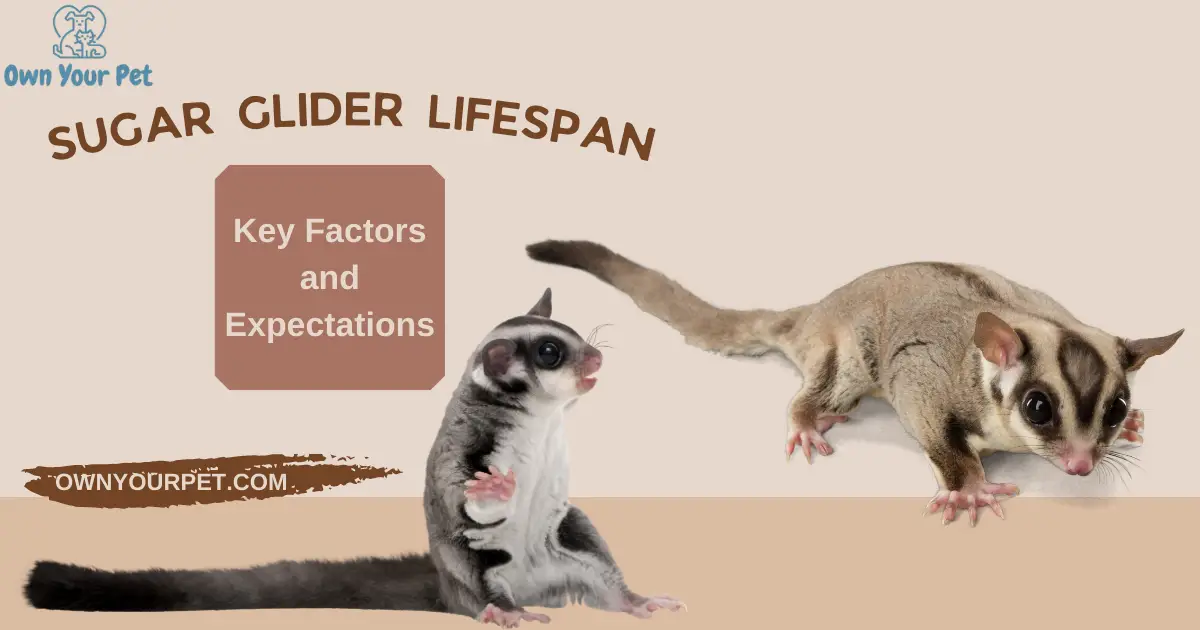Welcome to the world of sugar gliders! In this Sugar Glider Lifespan article, we will explore the lifespan of these adorable marsupials, discussing factors that influence their longevity and providing tips for their care. Discover the secrets behind these captivating creatures and ensure a fulfilling life for your sugar glider companion.
So, get ready to embark on an extraordinary journey into the world of sugar gliders—a journey that will surely leave you spellbound!
Sugar Glider Lifespan: Everything You Need to Know
Sugar gliders are fascinating small marsupials native to Australia, New Guinea, and Indonesia. These nocturnal creatures, scientifically known as Petaurus breviceps, have captured the hearts of many animal enthusiasts due to their unique appearance and incredible gliding abilities.
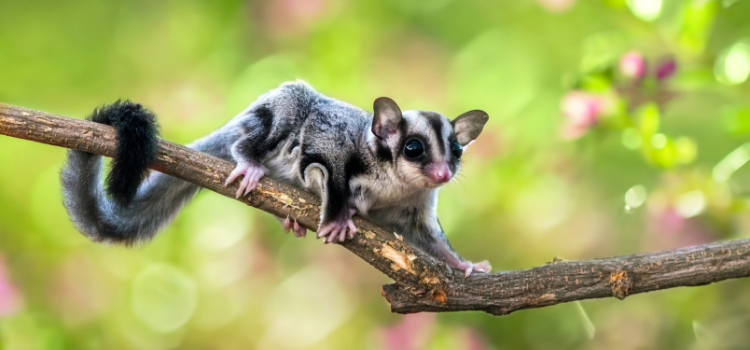
As more people express interest in these captivating animals, understanding their lifespan becomes an essential topic.
In the wild, sugar gliders can live up to 9 years, but their lifespan typically increases when they are kept in captivity. On average, these marsupials can live for 12 to 15 years under proper care, with a recorded maximum age of 17.8 years.
These adorable, tree-dwelling animals are known for their social behavior and enjoy living in groups, which can positively affect their overall well-being.
Caring for a sugar glider requires a thorough understanding of their nutritional needs, habitat requirements, and social dependencies. To ensure the optimal health and longevity of a sugar glider, owners must provide a balanced diet and a safe, cozy environment that mimics their natural habitat.
So, whether they’re gliding through the forests of Australia or snuggling in a pet owner’s pouch, these captivating marsupials can enjoy a long and healthy life with proper care.
Read next: 7 Best Small Pets For Cuddling
Sugar Glider Origins and Anatomy
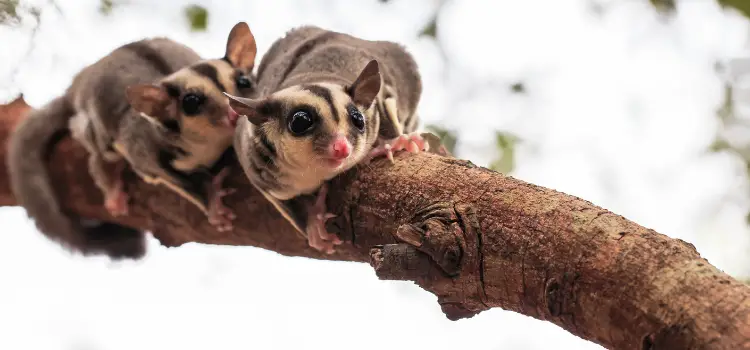
Anatomical Features
The sugar glider (Petaurus breviceps) is a small, omnivorous, arboreal, and nocturnal gliding possum that belongs to the marsupial infraclass. They have a unique gliding membrane, called a patagium, that extends from their wrists to their ankles, allowing them to glide through the air with ease.
Their body weight ranges from 100-160 grams, and their body length spans from 24-30 centimeters.
Some notable features of sugar gliders include:
- Big, black eyes, aiding in their nocturnal lifestyle
- Dark rings around their eyes
- A charcoal stripe running down their back
- Short, gray fur that resembles that of a koala
- Creamy-white belly fur
Natural Habitat
Sugar gliders are tree-dwelling animals that mainly inhabit forests and woodlands. Their nocturnal nature allows them to avoid many diurnal predators, and their gliding abilities help them move efficiently between trees in search of food and shelter.
In their natural habitat, sugar gliders usually live in groups of five to twelve, known as colonies. They can be territorial, and introducing new gliders to an existing colony may result in aggression or conflict.
Geographical Distribution
Sugar gliders are native to several countries, including:
- Australia
- New Guinea
- Indonesia
Their geographical range covers a variety of climates and ecosystems, showcasing their adaptability to different environments.
Diet and Nutrition
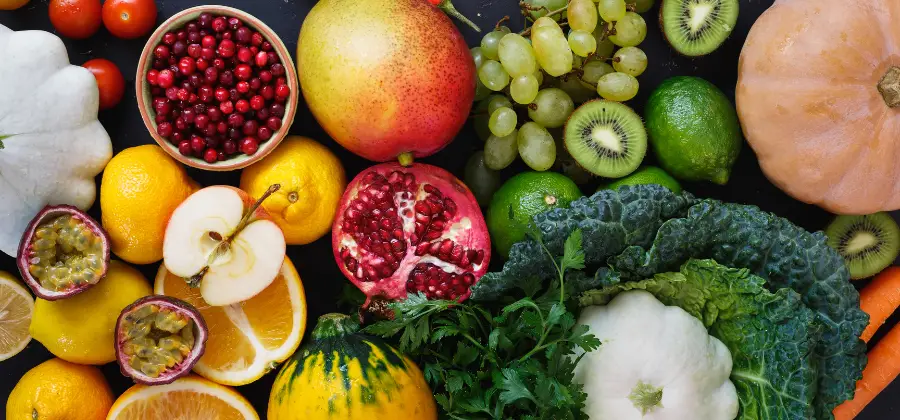
General Dietary Requirements
Sugar gliders are omnivorous creatures with a preference for sugary foods. Their diets include a wide range of items, such as:
- Insects
- Nectar
- Sap
- Vegetables
- Fruits
It is essential to provide them with a well-balanced diet to ensure they stay healthy and live a long life. Adequate nutrition also helps them maintain their gliding abilities and sharp senses.
Remember, though, their preferences may vary depending on if they are in the wild or captivity.
Feeding in the Wild
In their natural habitat, sugar gliders primarily consume:
- Insects, which serve as their main protein source
- Fruits and vegetables, providing energy and essential vitamins
- Tree sap and gum, which give their sweet tooth a boost
- Nectar from flowers, to maintain sufficient water intake
Their wild diet helps them meet their energy needs, while also providing some mineral and vitamin requirements.
Feeding in Captivity
When cared for in captivity, sugar gliders require a more controlled diet to provide all the needed nutrients. A typical captive diet includes:
- Leadbeater’s mix: A specially formulated mixture that contains a balance of protein, vitamins, and minerals
- Nutritional pellets: Supplements to ensure all nutrient requirements are met
- Fruits and vegetables: 2-3 teaspoons per day
- Insects and treats: Mealworms or other protein-rich insects can be provided occasionally
Keep in mind to provide access to fresh water for your sugar glider daily. With a well-balanced diet, they can live up to 15 years in captivity, while their wild counterparts live an average 3 to 9 years.
Housing and Environment
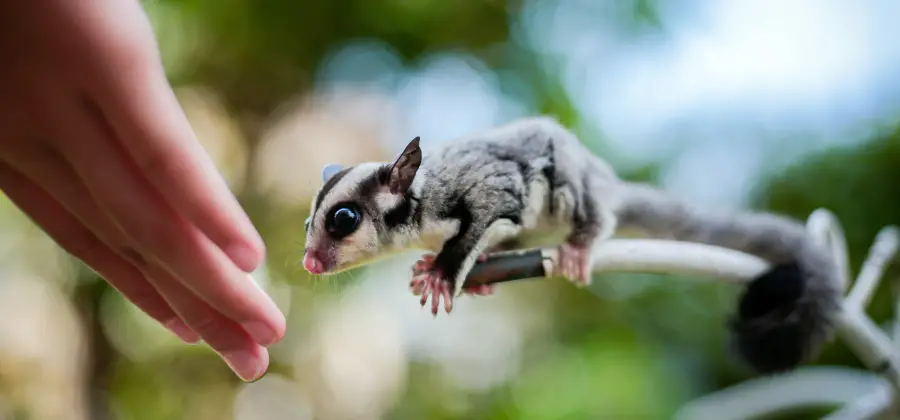
Cage Requirements
A sugar glider’s cage should be large and comfortable, mimicking their natural environment as closely as possible. The minimum cage size for a sugar glider should be 2 feet wide, 2 feet deep, and 3 feet tall.
Keep in mind that sugar gliders are arboreal animals, so providing plenty of vertical space is essential. Furthermore, ensure that the cage bars are no more than 0.5 inches apart to prevent accidents or escapes.
The cage material should be sturdy, such as metal or heavy-duty plastic, and easy to clean. You should also include branches or shelves at varying heights for climbing and perching, as well as a nesting box or pouch for nesting and sleeping.
Enrichment and Toys
Providing proper enrichment for sugar gliders is crucial for their physical and mental well-being. Enrichment can include various toys, such as:
- Foraging toys: Since sugar gliders are naturally inquisitive creatures, foraging toys can help keep them mentally stimulated. You can place treats or their favorite food inside these toys and watch them put their problem-solving skills to the test.
- Swings: Swinging toys can encourage movement and provide physical exercise for sugar gliders. Ensure that they are sturdy and have no small parts that can cause accidents.
- Ropes and Ladders: Climbing is an essential part of a sugar glider’s daily activities. Provide ropes and ladders in the cage for them to explore and climb up on.
Be sure to rotate toys regularly to keep sugar gliders entertained and prevent boredom.
Temperature and Safety
Maintaining a comfortable environment is crucial for sugar gliders’ health and well-being. The ideal temperature range for sugar gliders is between 70°F and 90°F (21°C and 32°C), with a humidity level of 40% to 60% to prevent dehydration.
At temperatures below 65°F (18°C), they can go into torpor, which could be fatal. So, make sure to monitor and maintain the right temperature in their living space.
In addition, keep their living space free from drafts, loud noises, and direct sunlight to avoid stress or discomfort. To ensure safety, place their living space in a quiet area of your home, well-ventilated and away from other household pets.
By providing adequate housing, enrichment, and a safe environment, you can help your sugar glider thrive and live a healthy life.
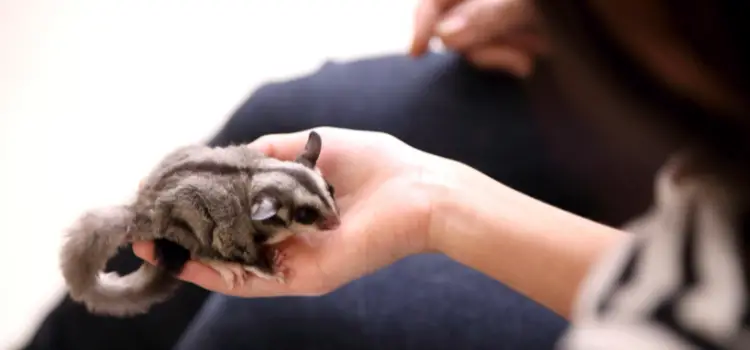
Nocturnal Behavior
Sugar gliders are primarily nocturnal animals, meaning they are most active during the night. This nighttime activity helps them avoid predators and stay hidden from potential threats. These creatures mostly spend their days sleeping in tree hollows, which provide them with shelter and a safe hiding place.
Social Interaction
Sugar gliders are social animals that live in groups called colonies. These groups can consist of up to 40 members, though the average size is smaller, typically around 7. They form strong bonds with other members of the group and provide each other with companionship, protection, and warmth.
One interesting aspect of sugar glider society is the presence of a dominant male in the group. This alpha male is responsible for protecting the colony from predators and ensuring the overall well-being of all members.
Sugar gliders are also known for their interactions with humans. They are often kept as pets and form strong bonds with their owners. They can be quite affectionate and playful, making them an attractive companion for people who are able to provide the appropriate care and attention that the animals need.
Vocalizations
Another unique aspect of sugar gliders is their wide range of vocalizations. They communicate with each other using various sounds and calls, ranging from loud shrieks to quiet chatters. Some of the most common sugar glider vocalizations include:
- Chirping: A happy sound made during playtime or when they find food.
- Barking: A loud call used to alert other group members of potential danger or to communicate over long distances.
- Hissing: A defensive sound made when they feel threatened or scared.
- Chattering: A quiet vocalization often associated with grooming or other close interactions with colony members.
Understanding and monitoring sugar gliders’ vocalizations can offer valuable insights into their emotional state, social interactions, and overall well-being.
Health and Sugar Glider Lifespan
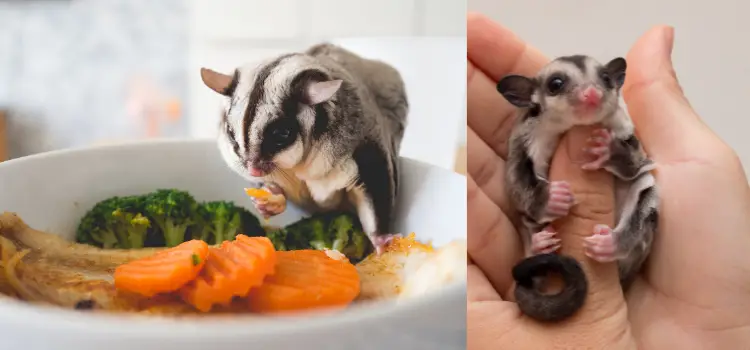
Sugar gliders are small, fascinating creatures with unique behaviors and anatomy. Maintaining their health and ensuring a long lifespan requires understanding their needs and providing proper care in terms of diet, enrichment, and veterinary care.
Common Diseases and Conditions
Sugar gliders can suffer from a variety of health issues, some of which include:
- Nutritional imbalances: A poor diet can lead to conditions such as calcium deficiency, which can be detrimental to their health.
- Parasites: These small animals can be affected by internal parasites, such as worms, and external parasites like mites.
- Stress-related ailments: Sugar gliders are sensitive to stress, which can weaken their immune systems and make them more susceptible to illnesses.
- Injuries: Due to their anatomy and gliding ability, sugar gliders can experience accidents that result in injuries or even broken bones.
Being attentive to their needs and providing appropriate care can help minimize the risk of these health issues.
Veterinary Care
Regular veterinary care is essential for sugar gliders to maintain good health and ensure a long life. It’s crucial to find a veterinarian experienced in exotic pet care who understands the specific requirements of sugar gliders. Regular check-ups and early intervention in case of health concerns can contribute significantly to their overall well-being.
Lifespan in the Wild vs. Captivity
In the wild, sugar gliders face many challenges, such as predators and harsh environmental conditions, which affect their lifespan. The average life expectancy for sugar gliders in their natural habitat ranges from 3 to 9 years.
On the other hand, sugar gliders living in captivity have a longer lifespan, typically ranging from 10 to 15 years, due to a controlled environment, proper nutrition, and regular veterinary care.
Providing the appropriate habitat, including a spacious cage, pouch for sleeping, and enrichment like toys or hiding places, enhances their quality of life and ensures they live a long, healthy life.
Watch this video: Sugar Glider Care for Beginners
Reproduction and Breeding
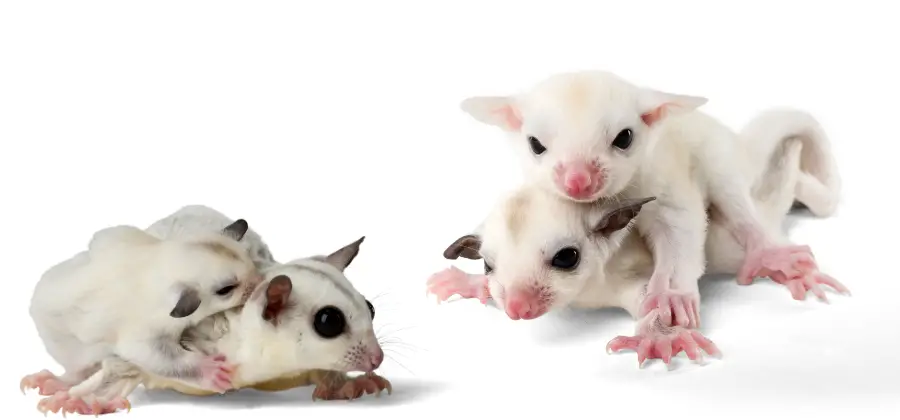
Mating and Courtship
Sugar gliders reach sexual maturity at different ages for males and females. Females become mature at 8 to 12 months old, while males reach maturity at 12 to 15 months old. They have an estrous cycle that lasts about 29 days.
The mating process begins with courtship, which is essential for males to gain female trust.
Gestation and Birth
Once the sugar gliders have successfully mated, the gestation period is relatively short, lasting only 15 to 17 days. As with other marsupials, females give birth to underdeveloped, small babies known as joeys. These newborns crawl into their mother’s pouch, where they continue to develop and grow.
Raising Joeys
Sugar glider mothers play a crucial role in raising their joeys. Inside the pouch, the joeys latch onto a teat and consume milk for nourishment. As newborns, sugar gliders depend on heat generated by their nest mates to stay warm. At around 70 days of age, the joeys’ fine, silky fur begins to grow in.
During this time, sugar glider parents become very protective of their offspring, using various strategies to ward off intruders. If the parents sense a potential threat or omen, they may go into a state of torpor, reducing their body temperature and metabolism to save energy. This survival tactic helps them maintain the safety of their young while conserving resources.
Read Next: 11 best Small Pets for Depression and Anxiety
Conservation and Threats
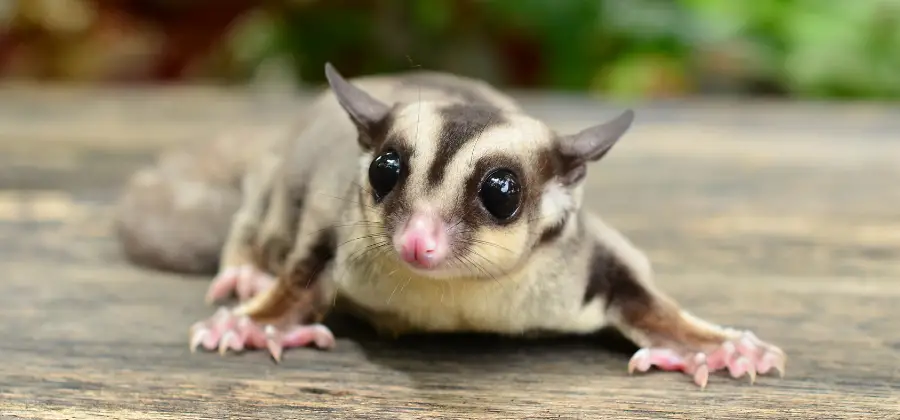
Threats in the Wild
Sugar gliders are small, arboreal, nocturnal possums that have a preference for sugary foods like sap and nectar. They have a diverse habitat tolerance, including degraded habitats, which contributes to their resilience in the wild.
However, they still face certain threats to their population, such as deforestation, fragmented forests, and competition with other species.
Sugar gliders rely on old trees with hollows for nesting, making them vulnerable in areas where these tree species are being removed or destroyed. Fragmented forests can also impede their dispersal and increase their contact with predators like feral cats.
Bushfires are another significant risk for sugar gliders since their habitats can be destroyed or severely disturbed by fire.
Conservation Efforts
Conservation efforts for sugar gliders mainly focus on preserving their habitats and mitigating the threats they face. Some of these efforts include:
- Planting and preserving old trees: Since sugar gliders depend on tree hollows for nesting, protecting and planting trees with hollows is critical for maintaining their populations. Programs that support the growth and preservation of old trees can help provide the sugar gliders with the nesting sites they need.
- Habitat connectivity: Ensuring that forests are connected—either naturally or through land bridges—can help sugar gliders disperse across landscapes more effectively. This connectivity can reduce the threat of populations becoming isolated and being vulnerable to local predators, like feral cats.
- Fire management: Responsible bushfire management can help protect sugar glider habitats from severe damage. Controlled and planned backfires can help reduce bushfire risk while ensuring that habitats remain relatively intact.
- Public awareness: Increasing public awareness about the importance of sugar gliders and their habitat requirements can contribute to better conservation practices. This can involve educational programs, events, and community-led initiatives to support sugar glider populations.
In summary, sugar gliders are resilient animals with diverse habitat tolerance. However, they face threats such as deforestation, fragmented forests, predators, and bushfires.
Conservation efforts involve habitat preservation, ensuring connectivity, fire management, and public awareness.
Sugar Gliders as Pets

Legal and Ethical Considerations
Before bringing a sugar glider into your home, it’s important to consider the legal and ethical implications. As exotic pets, sugar gliders may be subject to specific regulations in your area. It’s crucial to check your local laws and make sure you can legally own and care for these Australian natives.
Apart from legal considerations, it’s also essential to think about the ethical aspect of keeping exotic pets. As wild animals, sugar gliders require a specific environment and care to thrive. To ensure their well-being, it’s crucial to educate yourself about their needs and commit to providing them with a suitable habitat.
Adoption and Purchasing
Once you’ve done your research and decided to get a sugar glider, you have the option to adopt or purchase one. Adopting a sugar glider can be a great choice because it can give a loving home to an animal in need. There are several rescue organizations and adoption centers where you can find sugar gliders in need of a forever home.
If you prefer to purchase a sugar glider, make sure to look for reputable breeders or pet shops. These establishments should be able to provide you with the proper documentation and confirm the sugar glider’s origin to ensure you’re purchasing a legally sourced animal.
Proper Handling and Care
Caring for a sugar glider involves providing a suitable diet, ample space for exercise, and regular human interaction. Sugar gliders are omnivores, so their diet will need to be varied and replicate their natural diet as much as possible.
A proper diet is essential for their longevity, with most sugar gliders living 12-15 years under appropriate care.
In addition to diet, sugar gliders need ample space to move around, as they are agile and active animals. They have a unique ability to glide through the air, so providing a spacious habitat that allows them to express this behavior is important for their well-being.
Lastly, pet sugar gliders thrive on human interaction and companionship. They require frequent handling to maintain their tame temperament. This social nature makes them excellent pets for those who are willing to commit time and effort to bonding with their furry friend.
Conclusion: Sugar Glider Lifespan
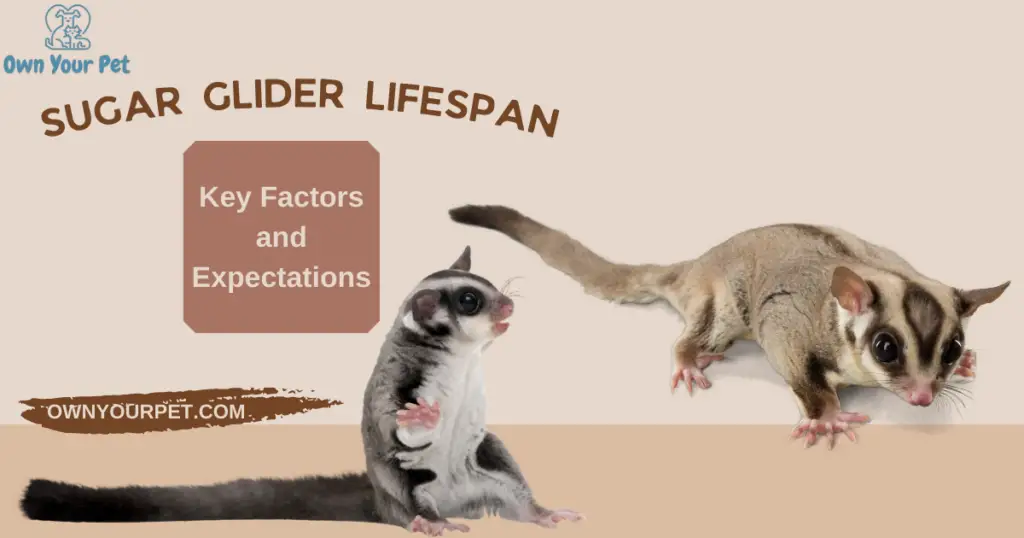
Are you fascinated by the mysterious and enchanting world of sugar gliders? These remarkable creatures, known for their incredible gliding abilities, have a lifespan that can bring joy to sugar glider owners for many years.
Female sugar gliders, which are usually cream in color, typically live for about 5 to 7 years in the wild, while with proper care and love from their human companions, they can reach the remarkable age of 12 to 15 years in captivity. But what factors contribute to their longevity?
Sugar gliders, with their opposable thumbs and agile hind legs, are well-equipped for their arboreal lifestyle, jumping gracefully from tree to tree. They are social creatures that thrive in the company of their own kind.
As baby sugar gliders grow and mature, they learn essential skills and behaviors from their parents, including foraging for fresh fruits and acacia gum—a vital component of their diet. Speaking of nutrition, a proper diet for sugar gliders is crucial to their overall well-being.
Their diet should consist of a variety of fruits, vegetables, and proteins, including hard-boiled eggs and sweet corn, ensuring they receive all the necessary nutrients.
While sugar gliders can be amazing companions, improper care can lead to health issues and a shorter lifespan. Sugar glider owners must provide a suitable sugar glider cage, offering plenty of space for climbing, gliding, and exercise. These intelligent creatures require mental stimulation and interaction, so don’t forget to spend quality time bonding with your furry friend. Remember, they are not just pets—they are family.
To ensure the best possible care for your sugar glider, it’s essential to consult a sugar glider care sheet or seek advice from experienced sugar glider enthusiasts. Regular check-ups with a veterinarian who specializes in exotic animals are also crucial. A professional can guide you on proper sugar glider care, including dental hygiene, as sugar gliders are prone to dental issues. By following these guidelines and providing a loving, stimulating environment, you can offer your sugar glider the best chance of a long and happy life.
If you’re considering adding a sugar glider to your family, be mindful that owning a captive sugar glider is a lifelong commitment. These captivating creatures are not just a glider for sale; they become a part of your life, bringing joy and companionship. Embrace the opportunity to care for these incredible animals and witness the wonders of their unique abilities and playful nature.
